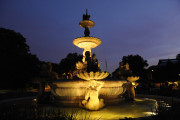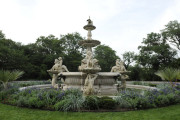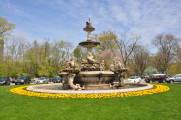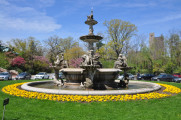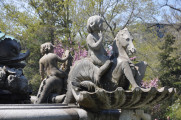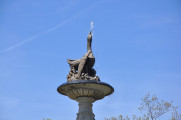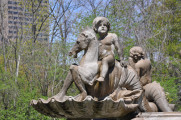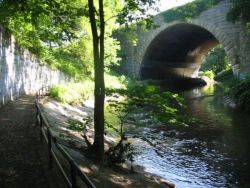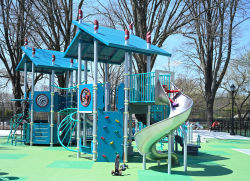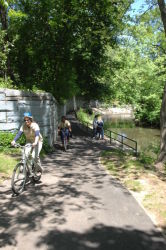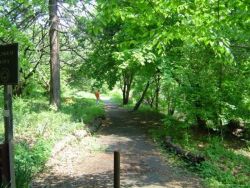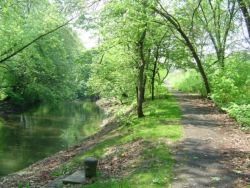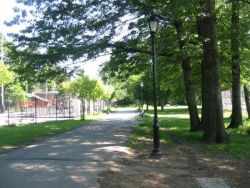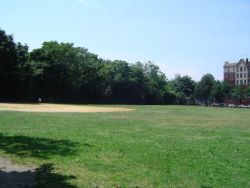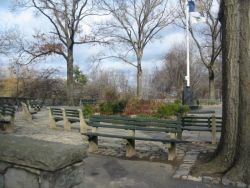Bronx Park
View all monuments in NYC Parks, as well as temporary public art installations on our NYC Public Art Map and Guide.
Rockefeller Fountain
| Artist: | Biagio Catella |
| Dedicated: | 1903 |
| Location: | Zoo, North end, Astor Court |
Artwork History
This elaborate sculptural fountain has a long and controversial history. Known as the Rockefeller Fountain, after the benefactor William Rockefeller (1841–1922) who gave it to New York City. The fountain, which is now an official New York landmark, once stood in Como, Italy.
In 1860, the City of Como began filling in portions of the harbor along Lake Como not being used for commercial traffic, to create Piazza Cavour—a place intended as a respite for tourists and residents alike. The new piazza was a mixed success. Its original purpose was never fulfilled, and it was used more as a dusty military parade ground. In 1870, a Milanese trader named Sebastiano Mondolfo, a villa resident at nearby Borgovico, and president of Lariana Shipping, offered the City 20,000 lira to purchase a monumental fountain from the Palazzo Litta at Lainate, that would be used to beautify Piazza Cavour.
The town fathers rejected the original plan, believing that a relocation of such a work of art from an aristocrat’s private palace to a public space was unacceptable. Instead, Mondolfo used his offer in 1872 to hire a local sculptor named Biagio Catella to design a new fountain. In less than six months, Catella and a team of artisans completed the three-tiered fountain carved of Bianco Pi Italian marble, and composed of a central image of a swan surrounded by sea creatures and ornamental carving. On September 23, 1872, the fountain was turned on. Though supplied by a small aqueduct on Mount Olimpino, the fountain served a practical community function by providing fresh water. The aesthetic result was the subject of heated debate, and even ridicule.
Some prudish observers took exception to the nude female naiad figures and the negative effects they might have on the morals of young children. Others felt that the swan more closely resembled an ungainly goose. The sea creatures in general were perceived as imagery that did not relate to the adjacent fresh-water lake. Those situated in the higher elevations of town were worried that the waters needed to operate the fountain demanded too much pressure from their neighborhood water supplies. The community was divided between those who revered the fountain and those who opposed its creation (the “anti-fontanisti”).
Poor construction and fiscal mismanagement appear to have settled the matter. The waters of the lake had badly eroded the landfill foundation by 1890. A municipal budget crisis left the city without the resources to repair and run the fountain, and it was dismantled and placed in salvage in 1891. In 1899, a local exposition and disastrous fire further undermined the city’s financial viability, and in an attempt to alleviate the local debt, the City Council authorized the sale of the fountain for 3,500 lira (the estimated equivalent then of $637).
In 1902, William Rockefeller purchased the fountain and invested an additional $25,000 to bring it to the City of New York, where it was installed at the Bronx Zoo in 1903. Later, the esteemed architectural firm of Heins and La Farge designed a new a ceremonial setting, and in 1910, the fountain was moved to its present location on the north side of the zoo at the Astor Court. In 1968, the fountain was designated an official New York City landmark, and is one of the few local monuments to be honored in this way.
Artwork Details
| Description: | Three-tiered, octagonal fountain with extensive sculptural program of sea creatures, etc. |
| Materials: | Bianco Pi Italian marble |
| Dimensions: | Diameter of largest basin 45'; Plaque: H: 1'1" W: 2' |
| Donor: | William Rockefeller |
| Cast: | 1872 |
Inscription
Bronze tablet THIS FOUNTAIN / FROM THE CITY OF COMO, ITALY / WAS PRESENTED BY / WILLIAM ROCKEFELLER / AND BY HIM ERECTED ON ITS PRESENT SITE / 1902 /Please note, the NAME field includes a primary designation as well as alternate namingsoften in common or popular usage. The DEDICATED field refers to the most recent dedication, most often, butnot necessarily the original dedication date. If the monument did not have a formal dedication, the yearlisted reflects the date of installation.
For more information, please contact Art & Antiquities at (212) 360-8163.
Check out your park's Vital Signs
Clean & Safe
Green & Resilient
Empowered & Engaged Users
Share your feedback or learn more about how this park is part of a
Vital Park System

